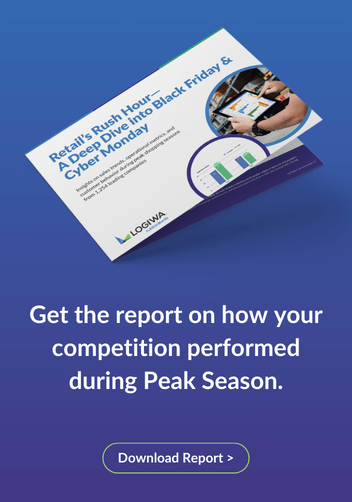This post covers the top WMS key performance indicators (WMS KPI) in the primary areas of operation for your warehouse. Specifically, we’ll cover
Contents
- Top receiving WMS KPI: dock-to-stock cycle time
- Top fulfillment WMS KPI: cost per order
- Top inventory WMS KPI: inventory accuracy
- The only return WMS KPI you need to worry about: rate of return
- How to use your Warehouse KPIs to improve performance and plan ahead
- Warehouse KPI benchmarking to plan for future growth
By prioritizing supply chain WMS KPIs that are most relevant to your warehouse operations, you can get a sense of your warehouse efficiency. Then you can dive even deeper into the relevant areas of your supply chain and assess subordinate KPIs.
BONUS: Before you read further, download our Warehouse Management Software Whitepaper to see how Logiwa tracks the following KPIs to help you get up to 100% inventory accuracy and execute advanced fulfillment strategies like wave planning.
Top Receiving WMS KPI: Dock-to-Stock Cycle Time
Most warehouses go through a similar process when receiving new inventory. Your inventory clerk will speak to the delivery driver to confirm which shipment they are delivering. Once your clerk confirms this order is expected, they’ll sign the delivery notice.
Next, your employees will unload the order from the truck, and count the crates and boxes. They’ll open each box to confirm the exact number of inventory, and inspect for damage. The delivery driver remains at the warehouse for this process to confirm any reported damage.
Finally, your employees will assign inventory numbers to your products before putting away in to shelves. Your inventory clerk will input the information into the warehouse and inventory management software. Depending on your system, you may be able to scan received inventory directly into your WMS.
Dock-to-stock cycle time is considered the chief of receiving KPIs. The cycle time starts the moment inbound shipments arrive, and stops once that inventory is stocked in your warehouse.
Warehouses with a high dock-to-stock time spend more hours on each of these tasks, impacting downstream tasks and operations.
Dock-to-stock covers a wide range of operations in your warehouse. Understanding other receiving related warehouse KPIs can help you see where your receiving process is doing well and where it needs some help.
In order to improve your dock-to-stock time, you’ll have to track all of the associated tasks. Task tracking can be easier when you incorporate mobile devices that integrate with a WMS. You’ll be able to review exactly which tasks happened at a precise time, allowing you to hone in on any areas that take longer than expected.
Receiving Efficiency
Receiving efficiency is a warehousing KPI that relates to dock-to-stock cycle time. It seems simple until you delve into what your warehouse actually receives on a weekly basis besides new stock deliveries. Your warehouse likely also receives return-to-vendor stock and returned inventory (both good and damaged) from customers.
You can calculate your receiving efficiency by taking your volume of received goods and dividing it by the number of labor hours for the same timeframe. Your receiving efficiency should continue to rise over time as your warehouse staff gain experience.
If your numbers trend lower over time, you’ll have to examine the receiving process firsthand to assess where you can gain efficiency in your warehousing process.
Put-Away Efficiency
Once you’ve received inventory, your employees must put them away. This particular warehouse KPI look at how accurately your employees execute the putaway process. Your warehouse should aim for 100% in terms of how well your employees put inventory away the first time.
If you’re consistently not making that 100% mark, you need to check for patterns in your employees’ put-away errors. Patterns suggest a learned mistake, or even something small, like an employee who consistently mixes up two products. The pattern may be that the same few employees misplace inventory, suggesting that retraining is in order.
Top Order Fulfillment KPIs: Cost Per Order
The order fulfillment process looks different based on the type of business you have.
- Is your business B2B or B2C?
- Do you satisfy dropship orders?
- Does product manufacturing begin with a customer order?
For our description, we’re assuming that the warehouse stocks all inventory prior to customer orders.
- Your customer places an order online.
- Your warehouse receives the order, and prints a pick list for the order is generated.
- Your employees walk the pick face, selecting the necessary inventory to satisfy the order.
- The items are delivered to the order packing area.
- Your packing employees will inspect each item and pack them appropriately based on packing slip .
- They’ll seal the box and move it to the shipping area.
- At the shipping area, the box will be weighed, and the best shipping strategy will be selected based on the shipping rates.
You can calculate your warehouse’s cost per order in a variety of ways depending on your operations. For a simple calculation, you would take:
Cost Per Order = Total Fulfillment Cost / Total Orders
Your goal is to reduce your warehousing cost per order over time. If this number increases, it may reflect growing inefficiencies in your fulfillment processes.
Order Cycle Time
Your order cycle time KPI will tell you, on average, how long it takes a customer’s order to ship once they place an order. Every second is crucial in ecommerce order fulfillment. You want as short an average time as possible. Your warehouse should be very responsive to your customers’ wants and needs. In this era of fast and free shipping, your customers don’t like waiting for their products.
A high average tells you that you have some issues to address in your picking, packing, or shipping workflows.
Order Picking Accuracy
Around half of customers say they’ve returned an online order because they received the wrong item. With online returns around 20% (and returns going to 30% around the holidays), you have to do what you can to decrease these costs. Increasing your order picking productivity and accuracy is an internal way of decreasing returns.
To calculate order picking accuracy KPI, you’ll take the total number of orders and subtract the number of incorrect item returns. Then you’ll divide that result by the total number of orders, and multiply it by 100 (for the percentage).
Order Picking Accuracy Percentage =
100 * (Total Orders – Incorrect Item Returns) / (Total Orders)
Top Inventory KPI: Inventory Accuracy
The work doesn’t stop once your inventory is on your warehouse shelves. Ideally, your inventory won’t be at rest for long, but while it is, it has to be maintained. Inventory counting is key for keeping track of stock inventory.
One of the top inventory management trends of 2019 is having a dedicated person for inventory control. This person would conduct or oversee inventory audits, and ensure the data is updated to reflect the reality in your warehouse.
This KPI will tell you how closely your inventory levels align with the actual inventory numbers in your warehouse. This KPI is important for warehouses that have high rates of incoming and outgoing inventory since more orders mean more opportunities for mistakes.
You can calculate this number by taking what WMS system says is on hand and dividing that number by what you actually have on hand. Then you multiply it by 100. Your goal is 100% inventory accuracy.
Inventory Accuracy Percentage =
100 * (Total Inventory Recorded in System / Actual Total Inventory)
Most companies have a set tolerance for discrepancy. After all, we’re only human. But inventory inaccuracy due to theft or poor inventory tracking should be dealt with as quickly as possible.
If you’re concerned about your inventory accuracy, then these other inventory KPI’s may be able to help you identify your warehouse’s inefficient work flows.
Inventory Turnover
Your inventory turnover rate is how many times you’ve sold your entire inventory in a specified time frame. This number can help you make strategic decisions regarding pricing, marketing, and new purchase orders. The inventory turnover formula is your cost of goods sold divided by your average inventory.
Inventory Turnover =
Cost of Goods Sold / Cost of Current Inventory
Inventory Carrying Cost
Inventory carrying costs tell you how much you will spend to store your inventory. Companies seek to keep carrying costs low since stored inventory represents tied up capital. You can lower carrying costs by consistently removing obsolete or deadstock. There are a few ways you can get rid of obsolete stock:
- Write-off the inventory at the end of the year
- Donate it for a tax deduction
- Bundle the inventory with similar items
- Sell the inventory at a discount
- Sell the inventory to a liquidation company
Take your carrying costs, and divide it by your overall inventory costs to find out this KPI for your warehouse.
Inventory Carrying Costs =
Carrying Costs / Inventory Costs
Backorder Rate
The backorder indicates how much of the total customer orders a warehouse can’t fulfill. This is an order fulfillment KPI all companies would like to keep at 0%. It typically varies depending on how quickly you can replenish out of stock inventory. This KPI impacts customer satisfaction, and depending on your customers, may also increase the number of requested refunds. Backorders test customer loyalty in a time where many customers aren’t loyal.
To calculate your backorder rate, divide the number of delayed customer orders by the number of total customer orders for a specific time period. Multiply the result by 100 for the percentage.
Backorder Rate =
100 * (Delayed Customer Orders / Total Customer Orders)
Return Related KPI’s
According to the National Retail Federation, Americans returned $260 billion dollars worth of merchandise in 2015. 8-10% of all purchases are returned, but online purchases typically see return rates of 30% or higher.
The primary return KPI you should be concerned with is the rate of order returns. You calculate this number by taking the number of returned items and dividing it by your total shipped items. You can play with this number further by using a specific return characteristic.
Rate of Return =
Total Returned Items / Total Shipped Items
Do you want to know the number of items returned because of damage because you ship fragile inventory? You can take the number of returns marked as damaged, and divide that by your total number of shipped inventory. Now you know that X% of all of your shipments were returned due to damage.
Sometimes orders are returned and it’s unavoidable. Other times, a little innovation can go along way. ASOS created an app called Virtusize that lets clothing shoppers compare the fit of new clothing to items they already own. They reduced fit-related returns by as much as 50%.
You can dig even deeper to see if most of these damaged orders are linked to a specific shipping carrier. If so, you now have the information to place responsibility for this damaged inventory.
Bonus: Read further to learn how to reduce ecommerce returns.
How to Use Supply Chain KPIs to Improve Performance and Plan Ahead
KPIs help you identify where your operations perform well and where there is room for improvement. Let’s say you see your cost per order has been steadily rising over the last few months. You take a look at the other fulfillment related KPIs and see that your order cycle time has also risen.
So now you know that the issue is in your picking, packing, and shipping process. An evaluation of this process in your warehouse(or your 3PL provider‘s warehouse) will give you the information you need to lower your cost per order.
With an understanding of your warehouse productivity and performance, you can avoid implementing tech to solve a problem too early, and only implement new tech in areas that are as optimized as possible. More supply chains are adding robots and other smart equipment to their warehouses. However, 43% of companies admit to not having a strategy for implementing AI in their supply chains.
So when you’re looking at your company’s future, understanding your current supply chain KPIs will help you innovate and optimize in the areas that will provide the most return on investment. That leads us to benchmarking your KPIs.
Better KPI Benchmarking = Better Warehouse Performance = Higher Profit Margins: Logiwa syncs accurate data across your entire interface so the inventory numbers you see on your dashboard are what your employees see on their devices. Learn how Logiwa uses real-time data to help you get up to 100% inventory accuracy and 2.5x shipments.
WMS KPI Benchmarking
Best-in-class supply chains operate at half the cost of their competitors, and they all have one thing in common. They benchmark their performance. Benchmarking can consume a lot of resources, but you have to know where you are in order to plan your course ahead.
Types of Benchmarking
Businesses normally engage in a few different types of benchmarking: internal, external, and strategic. All types of benchmarking have their uses, but you’ll have to plan out which type your business needs to engage in the most at the time.
Internal Benchmarking
If your company has data records, you can use that historical data to create some internal benchmarks for your warehouse KPIs. Having these benchmarks from internal data can show progress, even if your warehouse KPIs aren’t quite where you want them to be. If your inventory accuracy is at 95% now, but according to your historical data, 3 years ago it was at 80%, you still have some good news.
Internal benchmarking can be a great way to determine high and low performing warehouses as well. If you have a warehouse performing above or below the standard, then you can take a closer look to see what you can do to either duplicate or eliminate processes.
External Benchmarking
With external benchmarking, you examine other companies within your industry. This involves partnering to share information. Many times companies will bring in a third party to conduct an external benchmark to allow for safe sharing of information without leaving themselves open to corporate espionage.
Benchmarking Success is one of the premier benchmarking organizations, and they specialize in supply chain benchmarking. They’ve compiled a database of over 800 supply chains, and if you provide your data to them, they can provide an external benchmarking analysis. This particular method offers incredible information security.
Strategic Benchmarking
Strategic benchmarking is the hardest form of benchmarking to execute and analyze. When you strategically benchmark your organization, you look outside of your industry. You must be very careful which KPIs you select for comparison.
When you look across different industries, there are some comparisons that just can’t be made. However, looking outside your organization and comparing supply chain performance may reveal innovative solutions for your challenges.
What Are Your KPIs Telling You About Your Warehouse?
Remember, most supply chain KPIs give a snapshot in time. You have to benchmark and regularly recalculate these numbers to get the most from your data. Data is the first step to optimizing your warehouse, and changes in how we use and understand that data happen every day. Assessing your WMS KPI routinely will help you better understand your warehouse performance and make well-informed executive decisions.
An well-integrated WMS will be able to provide KPIs quickly, compared to calculating each one manually. A WMS provides a central repository for your data, ensuring that when you do run the numbers for KPI assessment, you’re doing so with the latest information.
Schedule a free WMS demo of Logiwa today.
Related Terms
Warehouse Management System KPIs
Explore six of the most important key performance indicators to track with your warehouse management system software.
WMS Features for SMBs
In this post we tell you which WMS features for SMBs are needed most. As a SMB there are benefits of warehouse management system.
WMS vs ERP
Discover the differences between Warehouse Management System vs Enterprise Resource Planning & how you can benefit – look now!
WMS Integration
If you’re thinking of integrating into a new WMS warehouse management system & wonder about impacts, this is a must-read.
Benefits of 3PL Software
Discover the amazing benefits of 3PL Software! Build your business & save money, without additional headcount.
Optimize multi-warehouse and multi-client operations at both the macro and micro levels
Warehouse Management
Modern digital WMS powers a modern fulfillment experience
Inventory Management
Improve your inventory across your supply chain.






